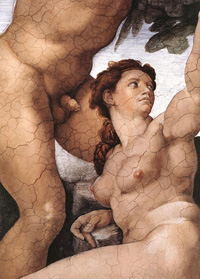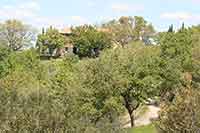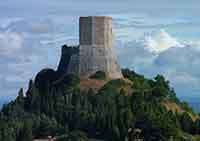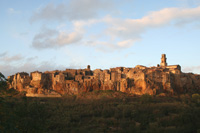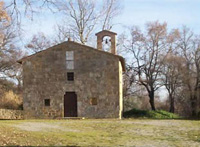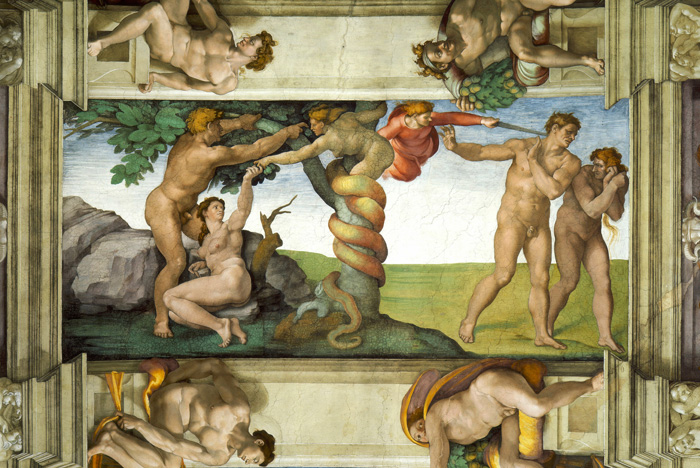 |
|
Michelangelo Buonarroti, Ceiling of the Sistine Chapel bay 4, The Fall and Expulsion from Garden of Eden, 1509-10, fresco, 280 x 570 cm, Cappella Sistina, Vatican |
|
Michelangelo Buonarroti | Frescoes in the Sistine Chapel | The Fall and Expulsion from Garden of Eden |
| The Sistine Chapel is the best-known chapel in the Apostolic Palace, the official residence of the Pope in Vatican City. It is famous for its architecture, evocative of Solomon's Temple of the Old Testament, and its decoration which has been frescoed throughout by the greatest Renaissance artists including Michelangelo, Raphael, Bernini, and Sandro Botticelli. The chapel takes its name from Pope Sixtus IV, who restored the old Cappella Magna between 1477 and 1480. The wall paintings were executed by Pietro Perugino, Sandro Botticelli, Domenico Ghirlandaio, Cosimo Rosselli, Luca Signorelli and their respective workshops, which included Pinturicchio, Piero di Cosimo and Bartolomeo della Gatta. The ceiling was frescoed by Piero Matteo d'Amelia with a star-spangled sky. The walls are divided into three orders by horizontal cornices; according to the decorative program, the lower of the three orders was to be painted with fictive "tapestries," the central one with two facing cycles - one relating the life of Moses (left wall) and the other the Life of Christ (right wall), starting from the end wall, where the altar fresco, painted by Perugino, depicted the Virgin of the Assumption, to whom the chapel was dedicated. The upper order is endowed with pilasters that support the pendentives of the vault. Above the upper cornice are situated the lunettes. Between each window below the lunettes, in fictive niches, run images of the first popes - from Peter to Marcellus - who practiced their ministry in times of great persecution and were martyred. Michelangelo was commissioned by Pope Julius II della Rovere in 1508 to repaint the ceiling; the work was completed between 1508 and 1512. He painted the Last Judgment over the altar, between 1535 and 1541, being commissioned by Pope Paul III Farnese. The overt subject matter of the ceiling is the doctrine of humanity's need for Salvation as offered by God through Jesus. It is a visual metaphor of Humankind's need for a covenant with God. The Old Covenant of the Children of Israel through Moses and the New Covenant through Christ had already been represented around the walls of the chapel.[1] The main components of the design are nine scenes from the Book of Genesis, of which five smaller ones are each framed and supported by four naked youths or Ignudi. At either end, and beneath the scenes are the figures of twelve men and women who prophesied the birth of Jesus. On the crescent-shaped areas, or lunettes, above each of the chapel's windows are tablets listing the Ancestors of Christ and accompanying figures. Above them, in the triangular spandrels, a further eight groups of figures are shown, but these have not been identified with specific Biblical characters. The scheme is completed by four large corner pendentives, each illustrating a dramatic Biblical story.[2] |
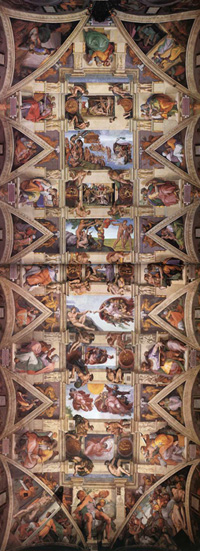 |
Nine scenes from the Book of Genesis
The sixth scene in the chronological order of the narrative, The Fall and Expulsion from Garden of Eden, is depicted in the large field of the vault of the second bay, between the triangular spandrels. |
||
The Temptation and Expulsion |
||
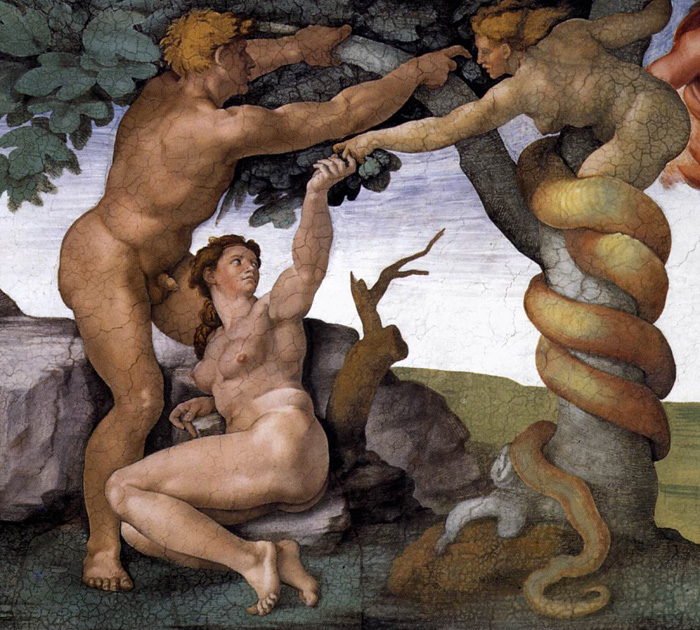 |
||
Michelangelo Buonarroti, Expulsion from Garden of Eden, 1509-10, fresco, 280 x 570 cm, Cappella Sistina, Vatican |
||
| A bold and momentous step towards greater clarity was taken with the Fall of Adam and the Expulsion from the Garden of Eden. It has been noted that the composition's three pilasters, the fallen pair to the left, the pair expelled from Paradise to the right, and the anthropomorphized tree of knowledge with the female tempter in the centre (the Tree of Life before the Fall), join arms at the top to form the letter M in uncial script. Was this intended to be Michelangelo's signature? To the left, the profusion of the Garden of Eden is indicated by a few details, but even among these a barren stump thrusts up its branches beside the archetypal female. To the right, total desolation surrounds the human couple. The rhythm of the whole composition flows from left to right. Eve grasps the apple boldly, Adam greedily, but in misfortune he seems greater than the woman. He knows that through his fall God, who was near to him, has become inaccessible and remote. He almost disdains the garden of which he feels no longer worthy. In spite of rocks and the barren tree stump, Eden - the term signifies bliss - is too voluptuous and full of delight; the bodies are too plump and smooth, the foliage above their heads is almost too luxuriant. It is as though Michelangelo meant to say: 'This is not yet the truth; that will have to be won in the desert of our destiny.' It is, moreover, striking that the cherub with the raised sword pointing the way out, although in flight and strongly foreshortened, appears a twin of the tempter and, like her, issues from the tree (the Tree of Life; the Cabalistic Sephiroth). Good and Evil have divided and become a dual power. This idea, like nearly every fresco on the vault of the Sistine, is full of mysteries which, we now realize, have their parallels in artistic and structural mysteries. Everything connects in Michelangelo's designs. In spite of their intellectual content, in spite of his humbly self taught knowledge, he never became literary; nor did he think in logical categories or in terms of dialectic, but visually and in symbols. |
||
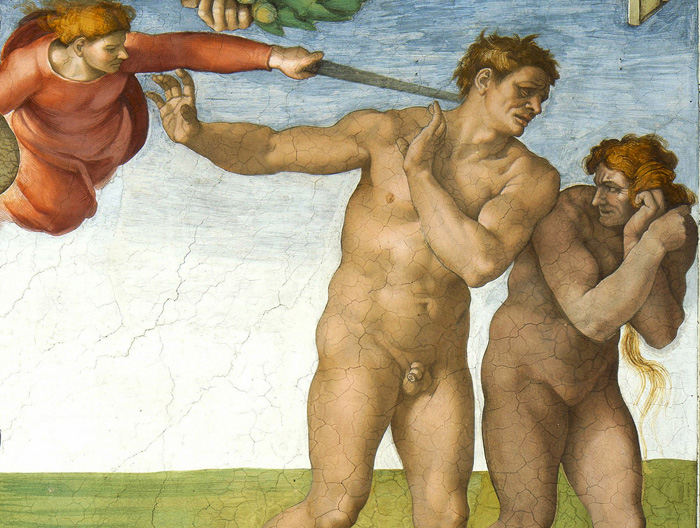 |
||
| Michelangelo Buonarroti, Expulsion from Garden of Eden, 1509-10, fresco, 280 x 570 cm, Cappella Sistina, Vatican | ||
|
||
[1] John Shearman, The Fresco Decoration of Sixtus IV in The Sistine Chapel, ed. Massimo Giacometti 1986, pp. 38–87 Study of the ceiling frescoes | www.wga.hu/tour Art in Tuscany | The Fall and Expulsion from Garden of Eden |
||
The Vatican Museums Opening Hours Open Monday to Saturday: the Ticket Office is open from 9 am to 4 pm. The Museums is closed at 6 pm. N.B. exit from rooms half an hour before closing time Sunday (except the last Sunday of every month, free entrance from 9 am to 12.30 pm; the Museums close at 2 pm unless it coincides with Easter Sunday, the 29th of June (St. Peter and Paul), 25th and 26th of December (Christmas and St. Stephen) |
||
 |
||||
Podere Santa Pia offers breathtaking views and is the ideal choice for those seeking a peaceful, uncontaminated environment |
||||
Holiday accomodation in Tuscany | Podere Santa Pia | Artist and writer's residency
|
||||
Podere Santa Pia |
Podere Santa Pia, garden view, April |
View from Podere Santa Pia
on the coast and Corsica |
||
View from terrace with a stunning view over the Maremma and Monte Christo |
Rocca d'Orcia |
Pitigliano |
||
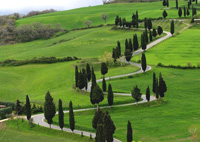 |
||||
Pieve di Santa Maria dello Spino |
Cipress road near Montichiello |
|||
| This page uses material from the Wikipedia article Sistine Chapel ceiling, published under the GNU Free Documentation License. |
||||

